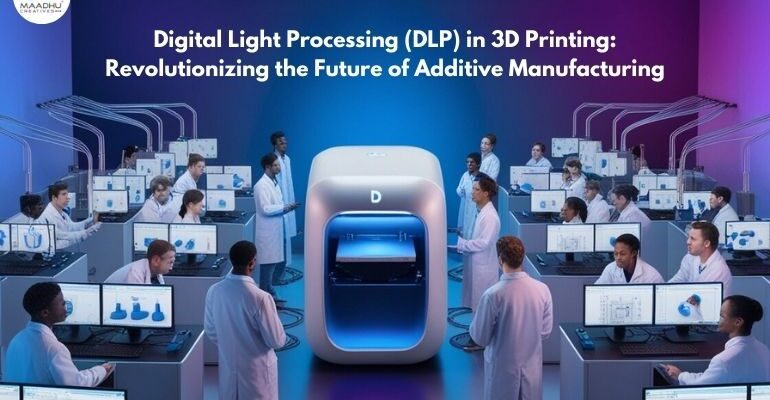In recent years, 3D printing has transformed industries, driving innovation and efficiency. Among the many printing technologies, Digital Light Processing (DLP) stands out as a cutting-edge method known for its speed, precision, and ability to produce high-quality prints. Initially developed for digital projectors, DLP has evolved into a leading technology in additive manufacturing. In this blog, we’ll explore how DLP works, its advantages, and its growing impact across industries.
What is Digital Light Processing (DLP)?
Digital Light Processing (DLP) is a resin-based 3D printing technology that uses light to cure photosensitive resin layer by layer. The key feature of DLP is that it exposes an entire layer of the model to light at once, unlike other technologies like SLA, which uses lasers to cure resin point by point. This allows for faster printing times and greater precision, making DLP ideal for applications requiring intricate detail, such as jewelry, dentistry, and rapid prototyping.
The DLP printer uses a Digital Micromirror Device (DMD) chip, which contains thousands or even millions of microscopic mirrors that tilt to project light patterns onto the resin. When the light hits the resin, it hardens, creating the model layer by layer. After printing, the model is cured further in a UV oven to ensure durability and stability.
How Does DLP Work?
-
Design and Slicing: The process begins with creating a 3D model using CAD software. The model is then sliced into thin layers to create projection patterns.
-
Projection and Curing: The DLP projector shines light onto the resin, hardening it layer by layer. The DMD chip projects a full image of each layer onto the resin surface.
-
Layer-by-Layer Construction: The model gradually takes shape as each new layer bonds to the previous one. Once the printing is finished, the object is washed to remove excess resin and cured in a UV chamber for final solidification.
Advantages of DLP in 3D Printing
1. High Resolution and Detail
DLP is known for its exceptional precision and ability to produce fine details. Whether it’s for dental models, jewelry prototypes, or intricate mechanical parts, DLP’s high-resolution capabilities ensure sharp and accurate features, making it the preferred choice for detailed applications.
2. Faster Printing Speed
Unlike technologies like SLA, which cure resin point by point, DLP projects an entire layer at once. This “full-layer” exposure results in significantly faster print times, especially for larger models. For industries that require rapid prototyping or small-batch production, DLP’s speed offers a substantial advantage.
3. Wide Range of Materials
DLP supports various materials, from flexible and durable resins to biocompatible options for medical applications. This versatility allows manufacturers to select materials tailored to specific needs, whether for functional parts, prototypes, or end-use products.
Applications of DLP in 3D Printing
The flexibility and precision of DLP technology make it ideal for a variety of industries, including:
- Healthcare and Dentistry: DLP is widely used for creating precise dental implants, crowns, bridges, surgical guides, and prosthetics. Its high accuracy is crucial for medical applications that demand customization and a perfect fit.
- Jewelry Design: DLP enables jewelers to create detailed and complex designs and prototypes before casting them into metal. It’s a cost-effective way to test intricate pieces without wasting materials.
- Rapid Prototyping and Product Development: DLP is essential for industries requiring quick turnarounds, such as automotive, aerospace, and consumer electronics, where functional prototypes are needed to test designs before full-scale manufacturing.
The Future of DLP in 3D Printing
As DLP continues to advance, the future looks bright for this technology. Key developments include:
- Faster and more efficient printers: Ongoing improvements in light sources and DMD chips will lead to even faster print speeds and higher throughput.
- Expanded material options: Future innovations may include materials with enhanced properties, such as high-strength, heat-resistant, or bioresin for more specialized applications.
- Integration with AI and Hybrid Manufacturing: Artificial intelligence could be used to optimize printing processes, while hybrid systems combining DLP with other manufacturing techniques may enable the creation of more complex parts and materials.
Conclusion
Digital Light Processing (DLP) is rapidly changing the landscape of 3D printing. With its superior speed, precision, and versatility, it is quickly becoming the technology of choice for industries like healthcare, jewelry, automotive, and rapid prototyping. As DLP continues to evolve, it holds the promise of even greater advancements, including faster print times, expanded material options, and more innovative applications. The future of manufacturing is brighter than ever, and DLP is at the heart of that transformation.
FAQs
1. What is DLP 3D printing used for?
DLP 3D printing is widely used for high-precision applications such as creating dental models, jewelry prototypes, medical implants, and functional prototypes in industries like automotive and aerospace.
2. How does DLP differ from other 3D printing methods?
Unlike methods like SLA or FDM, DLP uses a digital light projector to expose an entire layer of resin at once, resulting in faster print speeds and higher resolution details, especially for intricate designs.
3. What are the benefits of DLP in 3D printing?
DLP offers several advantages, including faster printing speeds, superior resolution, smooth surface finishes, and a wide range of materials, making it ideal for rapid prototyping, custom products, and high-detail applications.
